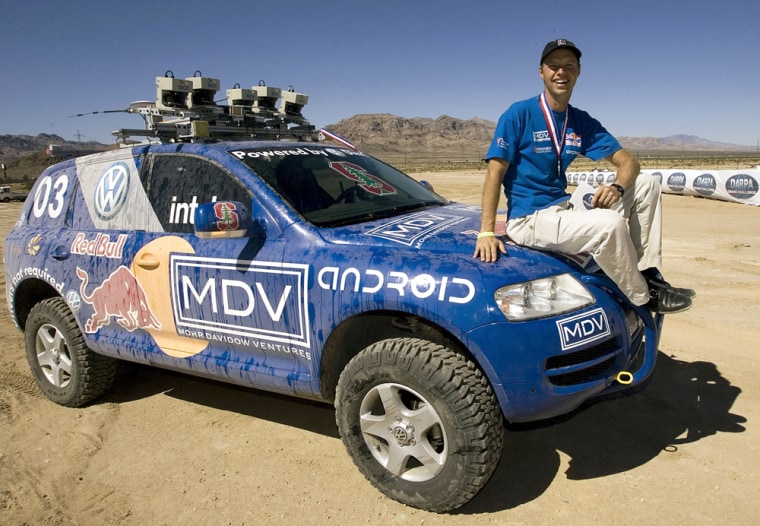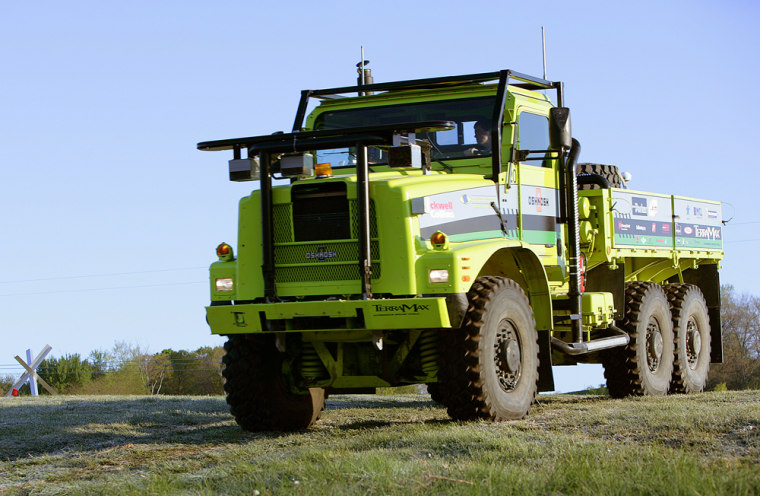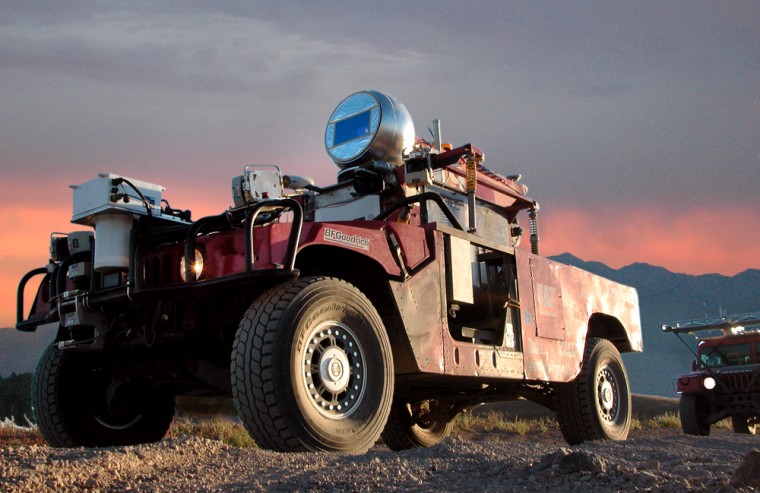March 27, 2006 - It was the kind of story you could make a movie about.
Scores of teams from all over the country devise riderless cars for a grand competition, with an elite field of 23 teams facing off in the Mojave Desert for the finals. In the end, it comes down to two teams. One is led by a grizzled ex-Marine. The other is guided by a soft-spoken, German-born professor. The prize? Two ... million ... dollars.
This is no made-up plot line from "Those Daring Young Men in Their Jaunty Jalopies." It's the real-life story of last fall's DARPA Grand Challenge, and it's finally coming to the screen in the form of a "Nova" public-TV documentary titled "The Great Robot Race."
The hourlong show, which makes its debut March 28, turns the Pentagon-sponsored Grand Challenge into a drama on the scale of a "Survivor" episode, even though the outcome of this particular reality-TV program is well-known. The film crews followed some of the teams for months before the race, delving into the personalities behind the pursuit:
- Sebastian Thrun, the German-born robotics professor, and his Stanford University team won the $2 million prize when their robotic Volkswagen, named Stanley, crossed the finish line at the end of a grueling 132-mile course.
- Carnegie Mellon University's Red Team, led by robotics professor and ex-Marine Red Whittaker, entered two vehicles in the Grand Challenge. Sandstorm, a modified Humvee that was a veteran of the first Grand Challenge back in 2004, came in a close second to Stanley. The Red Team's other entrant, a customized Hummer called H1ghlander, came in third.
- Two other teams completed the whole course: Wisconsin's TerraMax and Louisiana's Team Gray, which made a valiant effort just weeks after Hurricane Katrina hit their home base in Metairie, La.
- Then there are the lovable also-rans: Berkeley grad student Anthony Levandowski, whose quirky robo-motorcycle sometimes fell down and couldn't get up ... and Team D.A.D., two brothers who went from tinkering with "Battlebots" to tinkering with an autonomously controlled truck.
The show traces how the teams looked for that winning edge, whether it was the Red Team's sensor-equipped gimbal system or the Stanford team's multilayered steering software. In the end, however, the contest between Stanley and Sandstorm was decided by seemingly unpredictable twists of fortune — just like in the movies.

"The truth is, we were lucky to win, and Red could have easily won," Thrun told MSNBC.com.
The end of the race was by no means the end of the line for the racing teams. In fact, the whole point of the Defense Advanced Research Projects Agency competition was to encourage technologies that could someday be used to save lives in places like Iraq and Afghanistan. By 2015, the Pentagon hopes that a third of its ground vehicles will be autonomous, reducing the risk to military convoys in hostile areas.
By that measure, the Grand Challenge was worth the multimillion-dollar cost to the American taxpayer, said DARPA spokeswoman Jan Walker. "It was a good demonstration of the art of the possible," she told MSNBC.com.
Walker said the agency intended to sponsor yet another Grand Challenge, although she said it was too early to specify what form it might take or how much might be offered as a prize.
Stanford: Self-driving cars
The leading teams are already moving on to new challenges. For example, Thrun's team is trying to develop an autonomous automobile that can go from San Francisco to Los Angeles without a human touching the controls.
"I'm completely obsessed with the idea of making the self-driving car a reality, because it will be such a fundamental change for society," he said. Thrun noted that more than 40,000 Americans die annually in motor vehicle accidents — "about as many people as we lost in all of the Vietnam War" — and he hopes that robotic driving systems could cut that in half.
He said good progress already has been made in developing the components for such systems, including adaptive cruise control and lane-keeping assistants. "We're 60 percent of the way to the car that can go on I-5 and keep driving in a lane," Thrun said.
The goal is to demonstrate the S.F.-to L.A. feat by Oct. 8, 2007 — two years to the day since Stanley won the $2 million.
Some of that $2 million is going into the new effort, Thrun said, but "a good amount" of it also went to create an endowed fellowship for graduate students in engineering.
"We feel this is tax money, so we owe it to the taxpayer to make sure that the money is invested in a responsible way," Thrun said.
Oshkosh: Robo-trucks for the military
Oshkosh Truck Corp., the Wisconsin-based company that was the main sponsor of the TerraMax team, is already adapting the technologies from its Grand Challenge entrant for potential real-world scenarios.

In January, Oshkosh demonstrated a military transport vehicle outfitted with an autonomous-control kit similar to the one that was put on its 16-ton TerraMax truck for the robot race. The military vehicle, known as the Palletized Load System or PLS, transported cargo in unmanned mode over a 7-mile desert course at the U.S. Army Tactical Wheeled Vehicle Component Technology Demonstrations in Yuma, Ariz., said Oshkosh spokeswoman Kirsten Skyba.
"It went very, very well," she told MSNBC.com. "Now we're really at a stage where, if the U.S. military is interested in getting this on some of their vehicles, we're ready to move forward with that."
Skyba said the cost of installing the autonomous-control kit is "about the price of armoring a truck" — that is, less than $100,000.
Carnegie Mellon: Rovers and robo-farmhands
At CMU, Whittaker's Red Team is morphing into a corporation called Red Team Enterprises. "One of the effects of the Grand Challenge was to shift some of the enterprise from research to development and applications, and so part of the next phase is commercial," Whittaker told MSNBC.com.

The potential applications range from mining operations to environmental mapping to planetary exploration, Whittaker said.
To cite just one example, Whittaker's group is working with NASA's Glenn Research Center and Johnson Space Center on technologies that would be suited for the deep craters at the moon's south pole, where rovers would have to descend steep slopes and work autonomously during long communication blackouts. Such robots would have to "reason a great deal about the terrain and intricate movement on the slopes," Whittaker said.
"Agriculture is another arena that we're taking on," he said. The potential applications range from assisted navigation for tractors and self-propelled harvesters to fence-monitoring robots and pasture-clipping machines.
Even though the Red Team didn't come away with DARPA's $2 million prize, Whittaker looked back at the Grand Challenge as a grand success.
"For this team," he said, "it was always about the challenge of the technology, and the challenge of the course. ... In something like this, the only way to lose would be to not play. The Grand Challenge is just one of those things where there was no question that if it's robotics, and it's out there in the world, that's something that this team is going to be up for."
Correction for May 1: This report originally cited an incorrect timetable for the Pentagon's move toward autonomous vehicles.